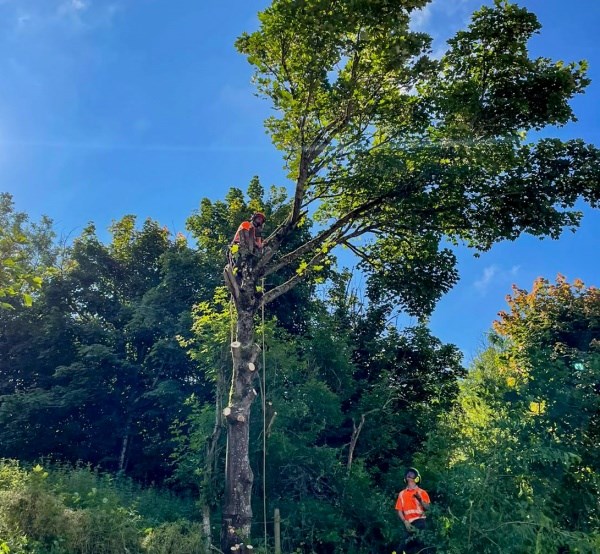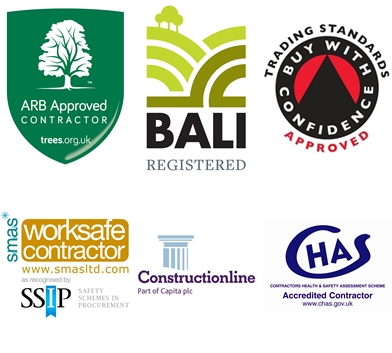Tree Lopping and Tree Pruning, are they the same or is there a difference?
The short answer to this question is - 'Yes they are very different'. At Bawden Tree Care we have noticed that often our customers are not aware of the differences between lopping trees and pruning trees, it is not uncommon for one to be confused for the other, not surprising really as they both relate to the removal of branches from trees.
Having completed a small survey of the terminology used in enquires and requests for tree maintenance received from customers we thought it would be a good idea to offer some help in explaining the key differences between tree lopping and pruning trees.
So here goes…….
Lopping
This the removal of branches, which maybe both large, small or both, from a tree, usually to reduce the overall size of it's canopy or crown. Lopping trees is often completed for aesthetic reasons, but also to encourage or train the trees to develop a specific form. Lopping branches can also involve the cutting out of damaged tree limbs or dead and failed.
It is important that this type of tree work is completed by professional tree surgeons as the removal of too much of the tree can be harmful in itself, potentially rendering it's eco system unviable for sustain long term survival . Other unwanted outcomes would include; putting the tree under stress, cuts, like wounds, can allow pests and diseases to establish and take hold. It is also quite easy to remove too much of the tree rendering it unsafe in terms of structure and balance, not a good outcome from a safety perspective.
And what about pruning trees then…….
Pruning
We think that tree pruning is a 'big subject' when compared with tree lopping, it covers a wider range of tree works - it also has quite a large number of mentions in the British Standard for Tree Work - BS 3998.
Previously we covered tree pruning in on of our 'FAQs' also see Pruning Terminology
Tree pruning can be summarised into four key areas:
- Formative Pruning.
- Crown Thinning
- Crown Lifting
- Crown Reduction and Reshaping
Each area has it's own key characteristics, depending on the outcome required and to some extent the age of the tree on which the pruning is to be completed. There are of course other forms of pruning , for instance to ensure that trees do not interfere with utilities such as telephone and electricity cables. Or to keep footpaths, roads and watercourses passable and free from obstruction.
Key considerations applicable to all pruning works:
- The structural integrity of any tree should not be compromised as a result of pruning trees.
- Pruning should encourage sustained growth and develop, works which would have negative impact on these should be avoided.
- The size and number of pruning cuts completed should be kept to an absolute minimum that are needed to achieve the objective of pruning the tree in the first instance. The trees health and viability depends upon it being able to generate enough energy to fight off disease and instances of decay. To do this it is important that the tree can bear sufficient leaf numbers, in addition every cut, just as with humans, provides the potential for disease and infection to take root.
- Timing of the work is important, we are all familiar with the need to complete pruning works at a seasonally appropriate moment, the same applies to other species as well. The objective of the pruning works may have some bearing on timing, but generally the species, age of the tree and overall condition should be the driving factors.
Pruning Trees - The Objectives
Why is the tree being pruned - what do you want to achieve?
Common pruning objectives include:
- Removing diseased wood from the specimen - improving the health of the tree and protecting it going forward.
- Removing damaged limbs and wood that may have occurred as the result of unintended actions, or adverse weather - improving the health of the tree and protecting it going forward.
- Removing dangerous limbs and wood, usually arising as a result of adverse weather - completed for health and safety reasons.
- Removing selected wood to promote new growth and the future form of tree - completed for sustainability and environmental reasons.
- Removing selected wood to promote and protect fruit harvests in the future - completed for sustainability, conservation and viability reasons.
Generic considerations relating to lopping trees and tree pruning
- Where possible work to the standards and techniques setout in BS 3998.
- Both types of works may require access to the tree canopy, working at height requires specialist training and equipment to reduce the risks involved.
- A degree of knowledge regarding tree species, diseases and cutting techniques is required.
- Green waste will be produced as a result of the works, this needs to be disposed of responsibly.
- In some cases trees are protected legally via TPO or due to their being located within a Conservation area. An understanding of the law and the parameters that apply may be needed.
The verdict……………
The Bawden Tree Care team hope that this short article has highlighted the key differences between tree lopping and tree pruning, the conclusion being that they are both very different.
It can still be confusing and difficult to get to grips with this and that is why we are here to help. As part of the relationship we like to develop with our customers, existing and potential we will always take time to discuss requirements and objectives - taking the mystery out of the terminology used by industry professionals.
If you need help with your lopping or pruning works please do contact us at info@bawdentreecare.co.uk - we look forward to hearing from you.
Finally - we hope you have found this article useful.


